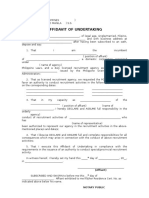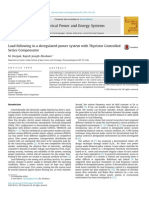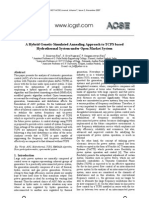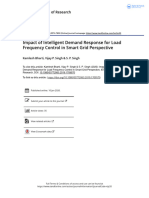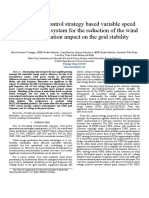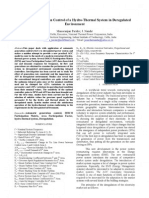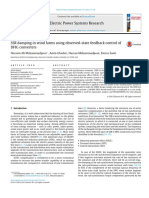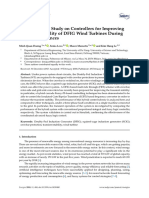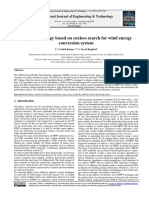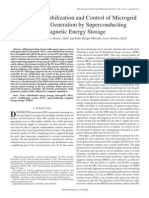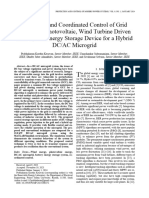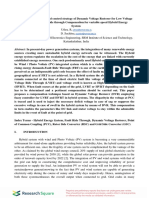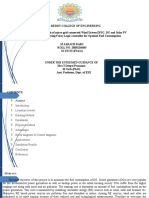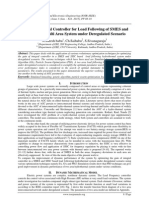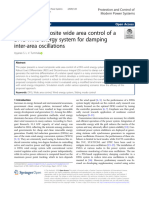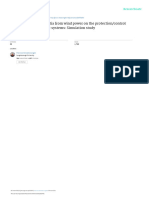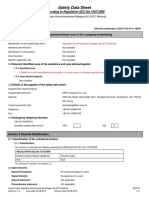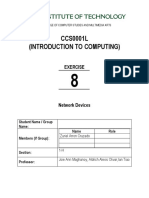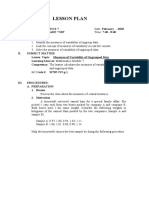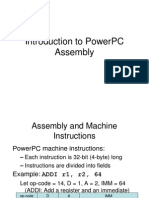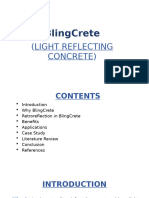Load Frequency Control of Interconnected Restructured Power System Along With DFIG and Coordinated Operation of TCPS-SMES
Load Frequency Control of Interconnected Restructured Power System Along With DFIG and Coordinated Operation of TCPS-SMES
Uploaded by
Cristina MendozaCopyright:
Available Formats
Load Frequency Control of Interconnected Restructured Power System Along With DFIG and Coordinated Operation of TCPS-SMES
Load Frequency Control of Interconnected Restructured Power System Along With DFIG and Coordinated Operation of TCPS-SMES
Uploaded by
Cristina MendozaOriginal Title
Copyright
Available Formats
Share this document
Did you find this document useful?
Is this content inappropriate?
Copyright:
Available Formats
Load Frequency Control of Interconnected Restructured Power System Along With DFIG and Coordinated Operation of TCPS-SMES
Load Frequency Control of Interconnected Restructured Power System Along With DFIG and Coordinated Operation of TCPS-SMES
Uploaded by
Cristina MendozaCopyright:
Available Formats
AbstractThe increased penetration of wind power by doubly
fed induction generator (DFIG) in power system results in higher
frequency excursion and increased rate of change of frequency in
the event of generation loss or increased load demand. This
paper presents the added feature of frequency regulation
capability of the DFIG by incorporating an extra frequency
control support function, tested on an interconnected two-area
restructured power system. Frequency control support function
responding proportionally to the frequency deviation is proposed
to take out the kinetic energy of the wind turbine for improving
the frequency response of the system. The presence of Thyristor
controlled phase shifter (TCPS) in series with the tie-line near
one area and Superconducting Magnetic Energy Storage (SMES)
at the terminal of the other area in conjunction with dynamic
active power support from the DFIG results in optimal transient
performance for PoolCo transactions. Integral gains of AGC loop
and parameters of TCPS and SMES are optimized through
craziness based particle swarm optimization (CRPSO) in order
to have optimal transient responses of area frequencies and tie-
line power deviation.
Keywords-Doubly Fed Induction Generator, Frequency
Regulation, SMES, TCPS
I. INTRODUCTION
ISPATCHING electricity in a way that ensures the
security of the system has always been a priority of
system operators. This priority has not changed during
the transition from vertically integrated utilities to competitive
market based operation [1].
Electricity systems are evolving rapidly and the inertial and
dynamic characteristics of many new sources of generation
differ from that of conventional plants in the past. The
increasing penetration of wind generation in systems has
caused concern about the availability of the turbines stored
kinetic energy to the system [2]. In isolated systems which
Praghnesh Bhatt is with Department of Electrical Engineering, CIT
Changa, Gujarat (pragneshbhatt.ee@ecchanga.ac.in)
S.P. Ghoshal is in Department of Electrical Engineering, National Institute
of Technology, Durgapur, WB (spghoshalnitdgp@gmail.com)
Ranjit Roy is with Department of Electrical Engineering, National
Institute of Technology, Surat, Gujarat (rrsvnit@gmail.com)
Sankarsan Ghosal is in Department of Electrical Engineering, National
Institute of Technology, Durgapur, West Bengal
978-1-4244-7781-4/10/$26.00 2010 IEEE
already have a relatively small inertial base, the penetration of
wind generation causes further reduction in system inertia.
This imposes significant problems to operators trying to
ensure the system security.
The increasing integration of DFIG controlled by static
converters for wind generation into power grids is currently a
generalized tendency in various countries. However, in case of
the DFIG, the inertia of the turbine is effectively decoupled
from the system. The static converter at the heart of the DFIG
controls the performance and acts as an interface between the
machine and the grid [3]. Hence, with the increased
penetration of the DFIG based wind farms, the effective
inertia of the system "seen" by the grid will be reduced which
results in increased rates of change of frequency (ROCOF)
due to disturbances. In order to allow operation with large
shares of wind power penetration, several utilities have put
frequency control requirement on wind farms. [4].
With the emergence of the distinct identities of GENCOs,
TRANSCOs, DISCOs and the ISO, many of the ancillary
services of the vertically integrated utilities have to be
modeled differently. One of the ancillary services is the
frequency control based on the concept of the load
frequency control [5]-[6].
Moreover, in competitive electricity market, Independent
Power Producers (IPPs) with various kinds of larger capacity
and fast power consumption apparatus do not possess
sufficient frequency control capabilities and may cause a
serious problem of frequency oscillations. Under this
situation, the conventional frequency control, i.e. a governor,
may no longer be able to absorb large frequency oscillations
due to its slower response. Therefore, a new service of
stabilization of frequency oscillations becomes challenging
and is highly expected in the future competitive environment.
Hence, the impact of coordinated control of
superconducting magnetic energy storage (SMES) [7] and
thyristor controlled phase shifter (TCPS) [8] is analyzed for
load frequency control. The SMES unit is located at the
terminal of area 2 and TCPS is considered in series with the
tie-line.
The objectives of the paper are to analyze the load
frequency control (LFC) problem of an interconnected two-
area restructured power system with the integration of wind
power generation by the DFIG and to show the effectiveness
of coordinated control of TCPS-SMES for LFC. In Section II,
the modeling of PoolCo transactions in restructured power
system has been discussed. Linearized model of an
interconnected two-area restructured power system along with
the integration of the DFIGs generation and TCPS-SMES is
presented in Section III. The modeling of the DFIG is given in
Load Frequency Control of Interconnected
Restructured Power System along with DFIG
and Coordinated Operation of TCPS-SMES
Praghnesh Bhatt, S.P. Ghoshal, Member, IEEE, Ranjit Roy and Sankarsan Ghosal
D
Section IV. Objective function to have the optimal transient
response and craziness-based particle swarm optimization
technique (CRPSO) [9] to optimize the gains of integral
controller and parameters of TCPS and SMES are outlined in
Section V. Simulation results are discussed in Section VI
followed by conclusion.
II. RESTRUCTURED POWER SYSTEM
The traditional electric industry is vertically integrated with
all generation, transmission and distribution. In the restructured
environment, vertically integrated utilities no longer exist;
instead, there are three different entities, viz., GENCOs
(generation companies), TRANSCOs (transmission
companies) and DISCOs (distribution companies). As there
are several GENCOs and DISCOs in the restructured power
system, a DISCO has the freedom to have a contract with any
GENCO for the transaction of power. A DISCO of one control
area may have a contract with a GENCO in another control
area.
A. DISCO Participation Matrix
The concept of a DISCO participation matrix (DPM) is
used to make the easier visualization of the contracts between
the GENCOs and DISCOs [5]-[6]. Each area is having two
GENCOs and two DISCOs as shown in Fig. 1. Let GENCO1,
GENCO2, DISCO1 and DISCO2 be in area1 and GENCO3,
GENCO4, DISCO3 and DISCO4 be in area2. Unlike the
traditional AGC system, a DISCO asks/demands a particular
GENCO(s) for load power. Thus, as a particular set of
GENCOs is supposed to follow the total load demanded by a
DISCO, information signals must flow from the DISCO to
particular GENCO(s) specifying corresponding demands.
There are also uncontracted loads like delPuncot1 and
delPuncot2 in area 1 and 2 respectively as shown in Fig. 1.
The individual total demands on GENCO(s) are specified
by
s
cpf (elements of DPM) and the pu MW load of a DISCO.
These signals which were absent in the traditional AGC will
carry information as to which GENCO has to follow a load
demanded by which DISCO. ( ) 1, 2, 3, 4
i
apf i = are the area
control error (ACE) participation factors of different
GENCOS, which were also absent in the traditional AGC.
11 12 13 14
21 22 23 24
31 32 33 34
41 42 43 44
DPM
cpf cpf cpf cpf
cpf cpf cpf cpf
cpf cpf cpf cpf
cpf cpf cpf cpf
=
(1)
III. LINEARIZED MODEL OF INTERCONNECTED TWO-AREA
MULTI UNITS RESTRUCTURED POWER SYSTEM ALONG WITH
TCPS AND SMES
Fig. 1 shows the linearized model of an interconnected two-
area restructured power system along with the integration of
12
1
i1
-K
s
i2
-K
s
T
12
s
12
2
1 1
1
2H s+D
2 2
1
2H s+D
TCPS
P
SMES
P
G,TH
1
1+s T ( )( )
HP RH
CH RH
sF T +1
sT +1 sT +1
G,TH
1
1+s T ( )( )
HP RH
CH RH
sF T +1
sT +1 sT +1
G,HY
1
1+s T
R
T P R
1+sT
1+s(R /R ) T
W
W
1-s T
1+s0.5T
G,HY
1
1+sT
R
T P R
1+sT
1+s(R /R ) T
W
W
1-sT
1+s0.5T
TH
1 R
TH
1 R
HY
1 R
HY
1 R
TT1
P
TT2
P
P
HH2
P
HH1
DFIG
P
Fig.1. Schematic of two-area system in restructured environment
( ) ,
p
C
0
1
2
WT
H s
mt
P
e
P
a
T
a
P
0 wt
0
27
0
0
1
1
f
sT +
P
ef
P
ref
er r
it
pt
K
K
s
+
0 cmd
T
0 wt
0 cmd
P
grid
f
f
f
K
e
P
p
L
eq2 2
1
2H s+D
1
WT
V
cmd
P cmd
I
1
1
con
sT +
WT
V
ref
f
DFIG
P
HH TT
P / P
Fig.2. Block diagram of the DFIG model with frequency support function
the DFIGs generation for the load frequency control. The
control areas are having thermal/hydro GENCO(s). DFIG is
placed along with the hydro GENCOs in area 2. The
generating units of GENCOs are represented by traditional
units blocks as given in [10]. The parameters are given in the
Appendix. The presence of TCPS in series with tie-line near
area 1 and SMES at the terminal of area 2 is also represented in
Fig. 1. The linearized model of TCPS and SMES are shown in
Fig. 3 and Fig. 4, respectively.
IV. MODELING OF DFIG
DFIG, being in the category of variable-speed wind turbine
generators, can offer increased efficiency in capturing the
energy from wind over a wider range of wind speeds, along
with better power quality and the ability to regulate the power
factor. The power electronic converter in the DFIG is attached
to the rotor. The rotor is connected to the power system
through the back-to-back ac/dc/ac converter, while the stator
is connected directly to the power system. Normally, the
control scheme of the DFIG decouples the rotational speed of
the rotor from the grid frequency, thus preventing the
generator from responding to the system frequency changes.
However, modern DFIG is designed to be able to vary its
rotational speed in a wider range during normal operations
which gives the possibility to utilize the rotational energy in
the turbine-generator to provide short term active power
support in the event of network frequency excursion [11].
A model of a multi-megawatt commercial DFIG (GE 3.6
MW) is used in this work, adopted from [12]-[13]. The block
diagram of the DFIG is shown in Fig. 2. The DFIG is
integrated with GENCO(s) in area 2.
The generated mechanical power ( )
mt
P is a complex functions
of wind speed ( )
s
, rotor speed ( )
t
and pitch angle ( ) . The
power coefficient
( ) p
C value of the turbine is given by (2).
( )
4 4
,
0 0
,
i j
p i j
i j
C
= =
=
(2)
The values of the coefficient
, i j
are given in [12]-[13].
0
t
s
R
= (3)
where
t
is the rotor speed in pu,
s
is the wind speed in
m/s,
0
is the rotor base speed in rad/s and R is the rotor
radius in meter. The mechanical power captured by the turbine
is given by (4).
3
,
1
2
r
mech p opt s
n
A
P C w
S
=
(4)
where is the air density in
3
kg/m ,
r
A is the rotor swept area
in
2
m ,
, p opt
C is the maximum value of the ( )
p
C curve at
0
0 ,
opt
is the optimal value of for which the value of
, p opt
C is maximum,
n
S is the DFIG rating in MW,
0
is the
rotor base speed in rad/s and R is the rotor radius in meter.
The values of these parameters for the GE 3.6 MW DFIG are
given in the Appendix.
The
p
C curves of the turbine based on (2)-(3) are plotted
for different pitch angles ( ) and shown in Fig. 5(a). Fig. 5(b)
presents the static dependency of the captured mechanical
power by the turbine as function of rotor speed for different
wind speeds. As may be seen from Fig. 5(b), there exists an
optimal rotor speed, for a given wind speed, when the
captured mechanical power is the maximum. This represents
the normal operation of the DFIG where it operates at the
maximum point of the ( )
p
C curve. Other than these optimal
rotor speeds, the captured mechanical power reduces
significantly.
A. Frequency Control Support Function added to the DFIG
Under normal operation, the convertor controllers of the
DFIG keep the turbine at its optimal speed in order to extract
maximum power. The controller gives a torque set point that
is based on measured speed and power. The power set point is
an input for the converter control that realizes the torque by
controlling the generator currents. To emulate the inertia and
to facilitate the excess active power injection from the DFIG
for the frequency support, an additional auxiliary signal is
considered and shown shaded in Fig. 2.
Upon the detection of a network frequency disturbance, an
active power increment as a function of the grid frequency
deviation in addition to the pre-disturbance value of nominal
active power is fed to the DFIG converter controller. Hence,
the electrical torque of the DFIG is now greater than the
mechanical torque generated for a given wind speed and the
DFIG rotor will experience the deceleration torque. As a
result, the rotational speed of the DFIG deviates from its
optimal operating point and extra rotational energy is
emulated from the rotor blades. This extractable kinetic
energy from the DFIG is used to supply more power to the
PS
K
1+s T
TCPS
P
i
(s)
12
T
Fig. 3 Structure of TCPS as a frequency stabilizer
SMES
K
SMES
1
1+s T
SMES
P
i
(s)
1
2
1+s T
1+s T
3
4
1+s T
1+s T
Fig. 4 Structure of SMES as a frequency stabilizer
2 4 6 8 10 12
0
0.2
0.4
Lambda
C
p
Beta = 0
Beta = 1
Beta = 3
Beta = 9
(a)
0.5 0.6 0.7 0.8 0.9 1 1.1
0
0.2
0.4
0.6
0.8
1
Rotor Speed (pu)
P
m
e
c
h
(
p
u
)
6.5 m/s
7.5 m/s
8.5 m/s
9.5 m/s
10.5 m/s
11.2 m/s
(b)
Fig.5. (a)
p
C (b) Wind turbine mechanical power as a function of the
wind turbine rotor speed for different wind speeds
grid in order to reduce the initial fall of frequency of the
system after the load disturbance. The deceleration of the rotor
and consequently extractable kinetic energy that is utilized to
generate dynamic active power support depends upon the grid
frequency deviation.
It should be noted that the DFIGs extra active power
supports the grid frequency in transient period only. The
integral controller in the AGC loop of the generating units
restores the frequency to the nominal value. As a result, under
stady state, additional power demand on the convertor
controller which is a function of the grid frequency deviation
shown in Fig. 2 is eliminated and normal operation of the
DFIG at the optimal rotor speed will be restored again.
V. MATHEMATICAL PROBLEM FORMULATION AND
CRAZINESS-BASED PARTICLE SWARM OPTIMIZATION
A. Figure of Demerit
The objective of the AGC is to reestablish primary
frequency regulation, restore the frequency to its nominal
value as quickly as possible and minimize the tie-line power
flow oscillations between neighboring control areas. In order
to satisfy the above requirements, gains ( )
I1 I2
K , K of integral
controllers in the AGC loops and parameters of TCPS and
SMES are required to be optimized. In the present work, an
Integral Square Error (ISE) criterion is used to minimize the
objective function defined as "Figure of Demerit (FDM)":
2 2 2
1 2 tie
FDM= f +f +P T
(5)
where T = a given time interval for taking 200 samples,
i
f = sample value of the incremental change in frequency of
ith area and
tie
P = sample value of the incremental change in
the tie-line power. The samples are obtained from their
respective plots derived through transfer function analysis.
The objective function is minimized with the help of CRPSO
based optimization technique [9].
B. Craziness-based Particle Swarm Optimization
The PSO was first introduced by Kennedy and Eberhart
[14]. It is an evolutionary computational model, a stochastic
search technique based on swarm intelligence.
Velocity updating equation:
( ) ( )
1
1 1 pBest 2 2 gBest
k k k k
i i i i i
v v c r x c r x
+
= + + (6)
Position updating equation:
1 1 k k k
i i i
x x v
+ +
= + (7)
The following modifications in velocity help to enhance the
global search ability of PSO algorithm as observed in CRPSO
[9].
(i) Velocity updating as proposed in [9] may be stated as in
the following equation:
( ) ( )
( ) ( ) ( )
1
2 1 2 1 1 pBest
1 2 2 1 1 gBest
k k k
i i i i
k
i
v r v r c r x
r c r x
+
= +
+
(8)
Local and global searches are balanced by random number r2
as stated in (9). Change in the direction in velocity may be
modeled as given in the following equation:
( )
( )
( ) ( )
( )
1
2 sign(r3) 1 2 1 1
pBest 1 2 2 1 1 gBest
k k
i i
k k
i i i
v r v r c r
x r c r x
+
= +
+
(9)
In (9), sign (r3) may be defined as
( )
( )
1 3 0.05
sign( 3) =
1 3 0.05
r
r
r
>
(ii) Inclusion of craziness: Diversity in the direction of birds
flocking or fish schooling may be handled in the traditional
PSO with a predefined craziness probability. The particles
may be crazed in accordance with the following equation
before updating its position.
1 1 craziness
( 4) ( 4)
k k
i i i
v v Pr r sign r v
+ +
= + (10)
where Pr(r4) and sign(r4) are defined respectively as:
( )
( )
craz
craz
1 4
( 4)
0 4>
r P
Pr r
r P
(11)
( )
( )
1 4 0.5
sign( 4)
-1 4<0.5
r
r
r
(12)
During the simulation of PSO, the best chosen maximum
population size = 50, maximum allowed iteration cycles =
100, best Pcraz = 0.2 (chosen after several experiments). The
choice of c1, c2 are very much vulnerable for PSO execution.
The best value of either c1 or c2 is 1.65. The value
of
craziness
i
v lies between 0.25 and 0.35.
VI. SIMULATION RESULTS AND DISCUSSION
Frequency responses of the interconnected two-area
restructured power system shown in Fig. 6 with the
penetration of DFIG have been investigated for PoolCo
transactions. Simulations are carried out by considering
Thermal-Thermal units in area 1 and Hydro-Hydro units in
area 2 (TT HH).The penetration of DFIG is considered only
in area 2. The presence of TCPS is considered in series with
the tie-line near area 1 and SMES is located at the terminal of
area 2. With the penetration of the DFIG in area 2, the droop
setting ( ) R and the system inertia
( ) eq
H of area 2 change, as
discussed below.
A. Computation of the Droop Setting and the System Inertia
due to the DFIG Penetration in Area 2
A.1 Computation of the droop setting
With the wind penetration level of
p
L , the droop setting is
given by (13).
( )
/ 1
Lp p
R R L = (13)
A.2 Change in the system inertia constant with the wind
penetration level,
p
L and DFIG does not provide frequency
support
The increased wind penetration displaces some portion of
generation of the generating units, thereby reducing the
system inertia. %
p
L wind penetration means %
p
L reduction in
the existing generation of the generating units i.e.,
%
p
L reduction in the system inertia, considering no frequency
support from the DFIG. The steady state load balance is
maintained by the %
p
L wind generation.
( )
,
1
eq Lp eq p
H H L = (14)
A.3 Change in the system inertia constant with the wind
penetration level of
p
L and DFIG provides frequency
support
The modified system inertia constant in the presence of
wind penetration level %
p
L along with the extra frequency
support is given by (15) [15].
( )
,
1
eq Lp eq p WT p
H H L H L = + (15)
The inertial contribution
WT
H from the DFIG as
experienced by the power system when the DFIG provides
e
P temporary extra active power support by utilizing its
rotational energy stored in the turbine blades is given by (16).
( )
2 1
ln
2
d
eq p
WT
p
T D
H L
X
H
L
= (16)
where
( )
2 1
1
d
eq p
T D
H L e p e p
L L
P L P L
X e
P P
= +
The computed values of the droop setting ( ) R and the
inertia constants
( ) eq
H after %
p
L wind penetration of DFIG
without and with frequency support function are used in area 2
of the linearized model of the interconnected two-area power
system (Fig. 1) in order to consider the equivalent impact of
the DFIG for the optimization purpose. However, for the exact
simulation in MATLAB/SIMULINK, ( ) R and
( ) eq
H will be
modified as per (13) and (14) respectively and the model of
the DFIG shown in Fig. 2 is integrated with the linearized
model of the system shown in Fig.1.
Transient Response of Interconnected Two-area Restructured
Power System with PoolCo Transaction
An event is simulated in which a system shown in Fig. 1 is
subjected to step load perturbations ( )
1 2 3 4
, , and
L L L L
P P P P
as given in (17)[5]-[6] at t = 5 sec.
0 5 10 15 20 25 30 35 40 45 50
-0.6
-0.4
-0.2
0
0.2
D
e
lt
a
f
1
(
H
z
)
0 5 10 15 20 25 30 35 40 45 50
-1.5
-1
-0.5
0
D
e
lt
a
f
2
(
H
z
)
0 5 10 15 20 25 30 35 40 45 50
0
0.05
0.1
Time (Sec)
D
e
lt
a
P
t
ie
(
p
u
)
(a) (b) (c) (d)
(a) (b) (c) (d)
(a) (b) (c) (d)
a) TT HH (b) TT-HHW with 20% wind penetration without f support (c)
TT-HHW with 20% wind penetration with f support (d) TT-HHW with
20% wind penetration with f support and TCPS-SMES coordination
Fig.6. Area frequency and tie-line power exchange for PoolCo transaction
0 10 20 30 40 50 60 70 80
0.25
0.3
0.35
0.4
P
e
o
f
D
F
I
G
(
p
u
)
0 10 20 30 40 50 60 70 80
0.92
0.94
W
w
t
(
p
u
)
0 10 20 30 40 50 60 70 80
0.3158
0.316
0.3162
0.3164
Time (Sec)
P
m
o
f
D
F
I
G
(
p
u
)
TT-HHW with 0.1 pu support
TT-HHW with 0.1 pu support & TCPS-SMES
TT-HHW with 0.1 pu support
TT-HHW with 0.1 pu support & TCPS-SMES
TT-HHW with 0.1 pu support
TT-HHW with 0.1 pu support & TCPS-SMES
Fig.7. Variation in DFIG electrical power, rotor speed and mechanical power
TABLE I
OPTIMIZED PARAMETERS FOR TEST SYSTEM
Optimized
Parameters
(a) (b) (c) (d)
Ki1 -0.0996 -0.106 -0.096 -0.05
Ki2 -0.0300 -0.030 -0.040 -0.05
K - - - 1.200
TPS - - - 0.100
KSMES - - - 1.900
TSMES - - - 0.050
T1 - - - 0.251
T2 - - - 0.012
T3 - - - 0.900
T4 - - - 0.379
FDM 6.5388 7.7738 5.1567 3.5615
(a) TT HH (b) TT-HHW with 20% wind penetration without f support
(c) TT-HHW with 20% wind penetration with f support (d) TT-HHW with
20% wind penetration with f support and TCPS-SMES coordination
1
,uncot1
2
3 ,uncot2
4
1 2 3 4
0.5 0.5 0.0 0.0 0.05
0.5 0.5 0.0 0.0 0.05 0
DPM , ,
0.0 0.0 0.5 0.5 0.05 0
0.0 0.0 0.5 0.5 0.05
0.5, 0.5, 0.5, 0.
L
L
L
L L
L
P
P
P
P P
P
apf apf apf apf
= = =
= = = = 5
(17)
Wind penetration level and wind speed are assumed to be
20% and 7.5 m/s respectively in area 2. When the DFIG does
not provide any active power support for frequency control, a
further frequency dip due to the decrease of system inertia with
the wind penetration may be seen from Fig. 6. In Fig. 6, the
imporvement in the frequency response is observed for the
case when the DFIG is participating for frequency control by
releasing extra active power support. In simulation, an
additional power demand ( )
e
P as a function of frequency
deviation is added on top of the converter reference point. As
a result, the rotor speed falls, transferring more kinetic energy
into the grid and compensating the increased step power
demand as shown in Fig. 7. The coordinated control of TCPS-
SMES in association with frequency control support function
from the DFIG considerably reduces the undershoot,
overshoot and settling time of area frequencies and tie-line
power exchange and gives optimal transient performance after
the load disturbances, as may be seen from Fig. 6.
Following the integral control actions of the existing
traditional generator units, finally, the area frequency
deviations become zero which consequently eliminates the
additional active power demand ( )
e
P and the DFIG turbine is
driven to operate again at the optimal rotor speed as may be
observed from the Fig.7. Table 1 shows the optimized
parameters for the test system.
In the steady state, generation of each GENCO must
match the demand of the DISCOs in contract with it. This
total generation of individual GENCO can be calculated by
(18) [5]-[6].
'
'
, cot
_ _ * _
_ *
G L
L un
P matrix cpf matrix P matrix
apf matrix P
=
+
(18)
CONCLUSION
The penetration of DFIG reduces the system inertia as its
rotational speed is decoupled from the grid frequency by a
power electronic converter. In this work, an extra frequecy
control support function is proposed which affects the
rotational speed of the rotor in the event of frequecny
disturbance and reduces the frequency dip by releasing short
term transient active power support. Simulation results show
that the sole participation of the DFIG and also the
coordinated action of DFIG-TCPS-SMES gives the optimal
dynamic performances of the area frequencies and tie-line
power exchange deviations in the event of load disturbance.
APPENDIX
.max
0
5.19s,0.5 0.00145, 0.5173, 8.76, 52m,
1.335rad/s, 5s, 0.02s, 3, 0.6, 1.0pu,
WT r n p opt
f con pt it WT
H A S C R
T T K K V
= = = = =
= = = = = =
,
, eq1
eq2 1 2 12 12 1 2
0.1, 0.2s, 1s, 0.38, 0.05, 5s,
0.05, 0.2s, 0.3, 7s, 0.3s,H =5,
H =3,D =D =1, T =2, =-1,B =B =21,f=60Hz,
HY G HY W T P R
TH G TH HP RH CH
R T T R R T
R T F T T
= = = = = =
= = = = =
REFERENCES
[1] A.J.Wood and B. F.Wollenberg, Power Generation Operation and
Control. New York: Wiley, 1996.
[2] L. Holdsworth, J. Ekanayake, and N. Jenkins, Power system frequency
response from fixed speed and doubly-fed induction generator based
wind turbine, Wind Energy, vol. 7, pp. 2135, 2004.
[3] S. Muller, M. Deicke, and R. W. De Doncker, Doubly fed induction
generator systems for wind turbines, IEEE Ind. Applicat. Mag., vol. 8,
pp. 2633, May/June 2002.
[4] Technical Requirements for the Connection of Generation Facilities to
the Hydro-Qubec Transmission System: Supplementary Requirements
for Wind Generation, Hydro-Qubec, Tech. Rep., May 2003, 2005.
[5] V. Donde, M. A. Pai, and I. A. Hiskens, Simulation and optimization in
an AGC system after deregulation, IEEE Trans. Power Syst., vol. 16,
no. 3, pp. 481489, Aug. 2001.
[6] Praghnesh Bhatt, Ranjit Roy and S.P. Ghoshal, "Optimized Multiarea
AGC Simulation in Restructured Power Systems", Int. Journal of
Electrical Power and Energy Systems, vol. 32, issue. 4, page. 311-322,
May 2010
[7] Tripathy SC, Balasubramanian R and Chandramohanan Nair PS. "Effect
of superconducting magnetic energy storage on automatic generation
control considering governor deadband and boiler dynamics", IEEE
Trans Power System, vol. 7, no. 3 pp.126673, 1992
[8] Praghnesh Bhatt, Ranjit Roy and S.P. Ghoshal, "GA/particle swarm
intelligence based optimization of two specific varieties of controller
devices applied to two-area multi-units automatic generation control",
Int. Journal of Electrical Power and Energy Systems, vol. 32, issue. 4,
page. 299-310, May 2010
[9] R. Roy, S.P. Ghoshal, "A novel crazy optimized economic load dispatch
for various types of cost functions" , Int. Journal of Electrical Power
Energy System, vol. 30, no. 4, pp. 242253, 2008
[10] P. Kundur, Power System Stability and Control. New York: McGraw-
Hill, 1993.
[11] J. Ekanayake and N. Jenkins, Comparison of the response of doubly
fed and fixed-speed induction generator wind turbines to changes in
network frequency, IEEE Trans. Energy Conversion., vol. 19, no. 4,
pp. 800802, Dec. 2004.
[12] N. W. Miller, J. J. Sanchez-Gasca, W. W. Price, and R. W. Delmerico,
Dynamic modeling of GE1.5 and 3.6MWwind turbine-generators for
stability simulations, in Proc. IEEE Power Eng. Soc. General Meeting,
Jul. 2003, pp. 19771983.
[13] N. W. Miller, W. W. Price, and J. J. Sanchez-Gasca, Dynamic Modeling
of GE 1.5 and 3.6Wind Turbine-Generators, GEPower System Energy
Consulting, Tech. Rep. Version 3.0, Oct. 2003.
[14] J. Kennedy, R.C. Eberhart, Particle swarm optimization, in: Proceedings
of IEEE International Conference on Neural Networks, Perth, Australia,
pp. 19421948, 1999
[15] Nayeem Rahmat Ullah, Torbjrn Thiringer, and Daniel Karlsson,
"Temporary Primary Frequency Control Support by Variable Speed
Wind Turbines Potential and Applications", IEEE Trans. Power.
Syst., vol. 23, no. 2, pp. 601612, May. 2008
You might also like
- Complaint Affidavit For Estafa and Violation of BP22 - ANTIBODocument5 pagesComplaint Affidavit For Estafa and Violation of BP22 - ANTIBOlyndon melvi sumiog100% (1)
- Affidavit of Undertaking Sra ISODocument2 pagesAffidavit of Undertaking Sra ISONLainie OmarNo ratings yet
- Thermostat Tms810Document7 pagesThermostat Tms810Katherin PazNo ratings yet
- Load Following in A Deregulated Power System With Thyristor Controlled Series CompensatorDocument10 pagesLoad Following in A Deregulated Power System With Thyristor Controlled Series Compensatorraa2010No ratings yet
- 5555-23408-1-PBDocument8 pages5555-23408-1-PBmehrnoosh.kamarzarrinNo ratings yet
- 1 s2.0 S2212017316305199 MainDocument10 pages1 s2.0 S2212017316305199 MainNebiyu TenayeNo ratings yet
- AGC of A Hydrothermal System With Thyristor Controlled Phase Shifter in The Tie-LineDocument7 pagesAGC of A Hydrothermal System With Thyristor Controlled Phase Shifter in The Tie-LineRajeshJosephAbrahamEdasseriathuNo ratings yet
- Load Frequency Control in Deregulated Power System Using Fuzzy C-MeansDocument8 pagesLoad Frequency Control in Deregulated Power System Using Fuzzy C-MeansaruljothiNo ratings yet
- Facts Based Controller For Interconnected Hydrothermal Power SystemDocument11 pagesFacts Based Controller For Interconnected Hydrothermal Power Systemnuzi62No ratings yet
- 1 s2.0 S0378779622008823 MainDocument17 pages1 s2.0 S0378779622008823 MainSouhila Rached ZINENo ratings yet
- 605 F9824 D 01Document7 pages605 F9824 D 01anitharoseline9859No ratings yet
- An Improved SMC Control Strategies For PMSG Based WECSDocument10 pagesAn Improved SMC Control Strategies For PMSG Based WECSGIRISHNo ratings yet
- An Innovative Fuzzy Logic Frequency Regulation Strategy For Two-Area Power SystemsDocument8 pagesAn Innovative Fuzzy Logic Frequency Regulation Strategy For Two-Area Power SystemsInternational Journal of Power Electronics and Drive SystemsNo ratings yet
- Adaptive Frequency Droop Feedback Control-Based Power Tracking Operation of A DFIG For Temporary FrequDocument11 pagesAdaptive Frequency Droop Feedback Control-Based Power Tracking Operation of A DFIG For Temporary FrequJoseph FranklinNo ratings yet
- LFC Demand RespDocument13 pagesLFC Demand RespAmar IndraNo ratings yet
- Agc DGDocument12 pagesAgc DGkasiNo ratings yet
- Atef 22622-45422-1-PBDocument11 pagesAtef 22622-45422-1-PBabidhafedh_842455669No ratings yet
- AGC Modelado Simulación IndiaDocument11 pagesAGC Modelado Simulación IndiacastrojpNo ratings yet
- Performance Analysis and Enhancement of Direct Power Control of DFIG Based Wind SystemDocument11 pagesPerformance Analysis and Enhancement of Direct Power Control of DFIG Based Wind SystemInternational Journal of Power Electronics and Drive SystemsNo ratings yet
- Robust Subsynchronous Interaction Damping Controller For DFIG-based Wind FarmsDocument12 pagesRobust Subsynchronous Interaction Damping Controller For DFIG-based Wind FarmsBinit ShresthaNo ratings yet
- Advanced Fuzzy Power Extraction Control of Wind Energy Conversion System For Power Quality Improvement in A Grid Tied Hybrid Generation SystemDocument11 pagesAdvanced Fuzzy Power Extraction Control of Wind Energy Conversion System For Power Quality Improvement in A Grid Tied Hybrid Generation SystemChristian JimenezNo ratings yet
- Low Voltage Ride Through Capability Enhancement Using Series Connected Fact Devices in Wind Energy Conversion SystemDocument20 pagesLow Voltage Ride Through Capability Enhancement Using Series Connected Fact Devices in Wind Energy Conversion SystemAsmaa A-ElghanyNo ratings yet
- 2 PDFDocument5 pages2 PDFvireshmathadNo ratings yet
- A High Robust Optimal Nonlinear Control With MPPT Speed For Wind Energy Conversion System (WECS) Based On Doubly Fed Induction Generator (DFIG)Document11 pagesA High Robust Optimal Nonlinear Control With MPPT Speed For Wind Energy Conversion System (WECS) Based On Doubly Fed Induction Generator (DFIG)Dang Quoc DuNo ratings yet
- SSR Damping Using GCSC and TCSC in Wind FarmsDocument10 pagesSSR Damping Using GCSC and TCSC in Wind FarmsIJIRAE- International Journal of Innovative Research in Advanced EngineeringNo ratings yet
- Improving Dynamic Performance of Wind Energy Conversion Systems Using Fuzzy-Based Hysteresis Current-Controlled Superconducting Magnetic Energy StorageDocument10 pagesImproving Dynamic Performance of Wind Energy Conversion Systems Using Fuzzy-Based Hysteresis Current-Controlled Superconducting Magnetic Energy StorageNch NMNo ratings yet
- Elearnica Ir SSR Damping in WindDocument10 pagesElearnica Ir SSR Damping in WindGanesh DuraisamyNo ratings yet
- Grid Stability PDFDocument6 pagesGrid Stability PDFSomagutta JahnaviNo ratings yet
- Automatic Generation Control of Hydro-Thermal System Deregulated EnvironmentDocument6 pagesAutomatic Generation Control of Hydro-Thermal System Deregulated Environmentapi-3697505No ratings yet
- Kamasdjhasgaeg PDFDocument10 pagesKamasdjhasgaeg PDFgag aaNo ratings yet
- Load Frequency Control of Hydro and Nuclear Power System by PI & GA ControllerDocument6 pagesLoad Frequency Control of Hydro and Nuclear Power System by PI & GA Controllerijsret100% (1)
- Electric Power Systems Research: Hossein Ali Mohammadpour, Amin Ghaderi, Hassan Mohammadpour, Enrico SantiDocument3 pagesElectric Power Systems Research: Hossein Ali Mohammadpour, Amin Ghaderi, Hassan Mohammadpour, Enrico SantiNDA BandNo ratings yet
- Stable Adapt at IveDocument9 pagesStable Adapt at IveGabriel Riquelme VeraNo ratings yet
- Paper - A Comparative Study On Controllers For Improving DFIG WTGs - 2018Document18 pagesPaper - A Comparative Study On Controllers For Improving DFIG WTGs - 2018Calum MartinNo ratings yet
- Abhas 680-684 PDFDocument5 pagesAbhas 680-684 PDFijrcctNo ratings yet
- A MPPT Strategy Based On Cuckoo Search For Wind enDocument6 pagesA MPPT Strategy Based On Cuckoo Search For Wind enbensumbbNo ratings yet
- IEEE Xplore 05659488Document13 pagesIEEE Xplore 05659488marcelo_molina_14No ratings yet
- Modeling of Wind Turbines Based On DFIGDocument8 pagesModeling of Wind Turbines Based On DFIGAida AdylbekovaNo ratings yet
- Limite Reactiva DFIGDocument9 pagesLimite Reactiva DFIGMartin__PringleNo ratings yet
- Modelling and Coordinated Control of Grid Connected Photovoltaic Wind Turbine Driven PMSG and Energy Storage Device for a Hybrid DC AC MicrogridDocument14 pagesModelling and Coordinated Control of Grid Connected Photovoltaic Wind Turbine Driven PMSG and Energy Storage Device for a Hybrid DC AC Microgridwondosen.wubuNo ratings yet
- Disturbance Observer Based Fractional-Order Integral Sliding Mode Frequency Control Strategy For Interconnected Power SystemDocument11 pagesDisturbance Observer Based Fractional-Order Integral Sliding Mode Frequency Control Strategy For Interconnected Power Systemjitenderkumar_goyal28No ratings yet
- AGC Deregulación NigeriaDocument6 pagesAGC Deregulación NigeriacastrojpNo ratings yet
- A Fuzzy Based Improved Control Strategy of DynamicDocument27 pagesA Fuzzy Based Improved Control Strategy of DynamicMatlab IEEENo ratings yet
- Robust Control Scheme For A Microgrid With PFC Capacitor ConnectedDocument11 pagesRobust Control Scheme For A Microgrid With PFC Capacitor ConnectedJitender KaushalNo ratings yet
- Adaptive Super-Twisting Sliding Mode Control For Wind Energy Conversion SystemDocument9 pagesAdaptive Super-Twisting Sliding Mode Control For Wind Energy Conversion SystemHAFEDH ABIDNo ratings yet
- Ext A Microgrid Based On Wind Driven DFIG, DG and Solar PV Array For Optimal Fuel ConsumptionDocument49 pagesExt A Microgrid Based On Wind Driven DFIG, DG and Solar PV Array For Optimal Fuel Consumptionsrimatrika enterprisesNo ratings yet
- Load Frequency Control of An Isolated Micro GridDocument11 pagesLoad Frequency Control of An Isolated Micro GridnhatvpNo ratings yet
- Tuning of Integral Controller For Load Following of SMES and SSSC Based Multi Area System Under Deregulated ScenarioDocument11 pagesTuning of Integral Controller For Load Following of SMES and SSSC Based Multi Area System Under Deregulated ScenarioInternational Organization of Scientific Research (IOSR)No ratings yet
- Impact of Large Offshore Wind Farms On Power System Transient StabilityDocument8 pagesImpact of Large Offshore Wind Farms On Power System Transient StabilityMadhusudhan SrinivasanNo ratings yet
- Inertia - Grid Inertia and Frequency Control in Power Systems With High Penetration of RenewablesDocument6 pagesInertia - Grid Inertia and Frequency Control in Power Systems With High Penetration of Renewablessatyajitebay3No ratings yet
- Energies 07 07694Document23 pagesEnergies 07 07694Heitor José TessaroNo ratings yet
- Tahir 2016Document16 pagesTahir 2016khaledNo ratings yet
- Model Predictive Control of Plug-In Hybrid Electric Vehicles For Frequency Regulation in A Smart GridDocument10 pagesModel Predictive Control of Plug-In Hybrid Electric Vehicles For Frequency Regulation in A Smart Gridmahmoud helalNo ratings yet
- Applied Sciences: Virtual Inertia: Current Trends and Future DirectionsDocument29 pagesApplied Sciences: Virtual Inertia: Current Trends and Future DirectionsEJAZ AHMADNo ratings yet
- Transient Stability of Power System Integrated With Doubly Fed Induction Generator Wind FarmsDocument11 pagesTransient Stability of Power System Integrated With Doubly Fed Induction Generator Wind FarmsAyaz ChowdhuryNo ratings yet
- Multi Verse Optimized Fractional Order PDPI Controller For Load Frequency ControlDocument15 pagesMulti Verse Optimized Fractional Order PDPI Controller For Load Frequency Controlsrinivasa rathnamNo ratings yet
- A Robust Composite Wide Area Control of A DFIG Wind Energy System For Damping Inter-Area OscillationsDocument10 pagesA Robust Composite Wide Area Control of A DFIG Wind Energy System For Damping Inter-Area OscillationsAR-TNo ratings yet
- IEEEDocument9 pagesIEEESagiraju DileepNo ratings yet
- DPSP 06227516Document7 pagesDPSP 06227516kevinkiangebeiNo ratings yet
- Bilateral Load Following in A Restructured Power System With Local ControllersDocument6 pagesBilateral Load Following in A Restructured Power System With Local ControllersRajeshJosephAbrahamEdasseriathuNo ratings yet
- EnergiesDocument16 pagesEnergiesSagiraju DileepNo ratings yet
- Advances in Energy Systems: The Large-scale Renewable Energy Integration ChallengeFrom EverandAdvances in Energy Systems: The Large-scale Renewable Energy Integration ChallengeNo ratings yet
- 8.metallurgy (New Indian Era) by PrashantDocument4 pages8.metallurgy (New Indian Era) by PrashantJuned MulaniNo ratings yet
- Jacobians of Matrix Transformations and Functions of Matrix ArgumentsDocument225 pagesJacobians of Matrix Transformations and Functions of Matrix Argumentsvenommax7No ratings yet
- EPCATDocument176 pagesEPCATaries2006No ratings yet
- CV Youssef Hussein Kanso (English)Document2 pagesCV Youssef Hussein Kanso (English)Youssef KansoNo ratings yet
- MSDS AstDocument6 pagesMSDS AstKRRNo ratings yet
- 100 Difficult Spelling Bee Words: With Pronunciations, Language of Origin, Definitions and SentencesDocument2 pages100 Difficult Spelling Bee Words: With Pronunciations, Language of Origin, Definitions and SentencesRodeo Roy Seriña DagohoyNo ratings yet
- Design and Realization of A Descretized PV System With An Improved MPPT Control For A Better Exploitation of The PV EnergyDocument14 pagesDesign and Realization of A Descretized PV System With An Improved MPPT Control For A Better Exploitation of The PV EnergyBipul TalukdarNo ratings yet
- Case Law CardsDocument6 pagesCase Law CardsParashuram PatilNo ratings yet
- Faculty of Pharmacy, Bahauddin Zakariya University, Multan.: Presented ToDocument50 pagesFaculty of Pharmacy, Bahauddin Zakariya University, Multan.: Presented ToKhilza aimanNo ratings yet
- J. Micah Roos - Shawn Bauldry - Confirmatory Factor Analysis-Quantitative Applications in T (2021)Document145 pagesJ. Micah Roos - Shawn Bauldry - Confirmatory Factor Analysis-Quantitative Applications in T (2021)irfanNo ratings yet
- Invoices and Memos 20231129Document30 pagesInvoices and Memos 20231129Raymar TeodoroNo ratings yet
- Cosh Session 2Document42 pagesCosh Session 2Andrea A. IgupNo ratings yet
- Dramatic MonologuesDocument10 pagesDramatic MonologuesJennifer JoynerNo ratings yet
- CCS0001L (Introduction To Computing) : ExerciseDocument4 pagesCCS0001L (Introduction To Computing) : ExerciseZuriel ArronNo ratings yet
- 04 Pediatric Basic Life SupportDocument2 pages04 Pediatric Basic Life Supportbunso padillaNo ratings yet
- Checked RBI Script - Grade 8 - ScienceDocument9 pagesChecked RBI Script - Grade 8 - ScienceLea BascoNo ratings yet
- Effects of Plyometric Training Versus Traditional Weight Training On Strength Power and Aesthetic Jumping Ability in Female Collegiate DancersDocument8 pagesEffects of Plyometric Training Versus Traditional Weight Training On Strength Power and Aesthetic Jumping Ability in Female Collegiate DancersJessica FoongNo ratings yet
- Lesson Plan 7 Cot 3 Measures of Vaiability of Ungrouped DataDocument7 pagesLesson Plan 7 Cot 3 Measures of Vaiability of Ungrouped DataVanissa Bianca Llanos100% (2)
- PPC Assembly IntroDocument36 pagesPPC Assembly IntroMohammad Gulam AhamadNo ratings yet
- Libro de Inglés PreescolarDocument10 pagesLibro de Inglés Preescolarvanesaarellano95No ratings yet
- Tax Saving Instruments of Income Tax in India: A Study On Tax Assessee in Trichy CityDocument12 pagesTax Saving Instruments of Income Tax in India: A Study On Tax Assessee in Trichy CityPallavi Pallu100% (1)
- Seminar ReportDocument30 pagesSeminar Reportmuhammedsahad906194No ratings yet
- Sabena Airlines' AllegationsDocument7 pagesSabena Airlines' AllegationsMaricar Grace Magallanes VelascoNo ratings yet
- Chapter 6Document101 pagesChapter 6Bình NguyễnNo ratings yet
- Don Tumasonis - Five Strange TalesDocument78 pagesDon Tumasonis - Five Strange TalesNapoleon PalaciosNo ratings yet
- Ex Oriente Ad Danubium BT-libreDocument247 pagesEx Oriente Ad Danubium BT-librelion_kanzenNo ratings yet
- Chapter 12 Test Bank - Version1Document25 pagesChapter 12 Test Bank - Version1-No ratings yet


